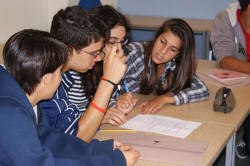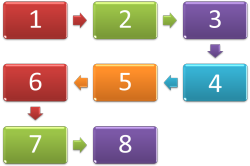How to write a Delta lesson plan
 |
A poor teacher can teach successfully
with a good plan but a good teacher cannot teach successfully with a
poor plan. |
Before doing all this, you may want to follow a basic guide to planning (new tab).
 |
Twelve into four |
There are twelve assessment criteria for the plan for a Delta
lesson but they address four critical planning areas.
The four essential stages to any sort of plan are:
- You need to set aims which you hope to achieve. These
will be aims for you as a teacher concerning what you will teach
and they will also include outcomes for the learners in terms of
what they will get from the lesson.
You have to be clear about your aims from the outset or nothing will work properly.
You also have to set aims and objectives which can be successfully achieved in the time you have. - Now you have to look at how you get from where you and the learners are now to where you and they want them to be. This involves selecting and designing activities and procedures which are focused on achieving part of the aims and objectives at a time. Do not include activities which do not target the aims.
- You need to plan a way to check how things are going. If you don't, you will be in danger of carrying on with something unnecessarily or moving on too quickly and spoiling whatever comes next. Both you and the learners need frequent checks to make sure you can measure and be seen to measure progress.
- Finally and in combination with stage 3, you need to select,
design or amend materials to suit the aims. Don't work
backwards from the materials to the aims because that does not
take into account what the learners want to achieve.
Materials-driven lessons are rarely successful lessons.
Here's the picture

We'll take each element of the plan separately and match the content
of the plan to the Delta assessment criteria.
Also included in this guide are typical criticisms made by Delta
assessors. Be careful to ensure that they can't be levelled at you
and your planning.
A lesson can pass or fail on the strength of its plan so this is not a
box-ticking exercise.
Your role is not just a planner, as we shall see.
 |
The learners |
All plans start with a consideration of the learners, their needs, their learning preferences and their interests so it's unsurprising that this is the first criterion for a Delta assessment.
5a) includes
(i) a brief general overview of the group of learners and the course
(ii) information about individual learners relevant to the lesson
Here you need to explain the context of the lesson. It may be that your observer-assessor knows most of this but it is unlikely that an external assessor will. The key question to ask is
What do I need to tell the observer to make the context clear?
Do that but do no more.
 |
What assessors sometimes say: The information on the class is incomplete in terms of ... (followed a by a range of areas including context, needs and the setting). The candidate has provided too much that is not relevant so it is difficult for her to identify key issues. There is information on the individuals in the class but too little / nothing that is relevant to the aims and design of this lesson. |
It is here that you demonstrate your familiarity with the group and the fact that there are some commonalities to bear in mind when planning for them. If you are sharing a class, do not rely on other people's perceptions (but draw on them). It is your view and your response to the group that is most important.
To meet 5a) (i)
Set out the following (in a grid or table if you like):
| Item | Example |
| the length of the course and its aim | this course runs over six weeks and
started on ... its general aim is to help these B1-level learners use English in their workplaces |
| intensity and timetable | the group meets for 3 hours, twice every week in the evening |
| teachers | there are two teachers who share the
timetable equally, one focusing on productive skills, the other
on receptive skills. I am the first of these. structural and lexical issues are dealt with in the context of skills work I have taught the group for ... |
| group | most members of the group are
well educated professionals (in a variety of fields) in their
20s and 30s the group is reasonably homogenous in terms of level although some have weak writing skills attendance is compulsory but somewhat variable |
That's enough. There is no need, unless the group is very unusual,
to say more here.
There may be an unusual item worth adding to the
list. For example, if the group is particularly heterogeneous, has
split aims and so on. Before you write something about this, ask
yourself if it's really relevant to your lesson. If it isn't,
leave it out.
It's important to state your familiarity with the group. The less
you have, the less will be expected of you in certain areas. (That
is not, however, an excuse for not doing research into
needs, preferences and abilities.)
TASK: what would you say about the group you are currently teaching or have recently taught?
To meet 5a) (ii)
Here your focus is on the individuals in relation to the lesson you are planning.
The data are probably best set out in a grid, but you may need to
vary the columns to suit your group. For our example, all the
learners have the same aims but your group may be less homogenous and
you'll need to include a column for Reasons for learning, for
example. Special needs, too, may need a column or a comment such
as:
Jose is a little deaf
so needs to sit near the front to hear me clearly and to be face-to-face
in any pair-work or group-work activity.
| Individual | Age, gender | Nationality | L1 | Other languages | Occupation | Particular interests | General ability | Ability etc. relevant to this lesson | Attendance and motivation | Learning preferences | Other comment |
| Learner 1 | 27, F | Swiss | Italian | Excellent German | IT engineer | IT and films | Average for the group in most skills but with weak pronunciation and confidence | She will struggle with the pronunciation stage and may be reticent in role plays | Perfect attendance and high motivation She says she enjoys the problem-solving nature of learning a language |
Is reflective and individual, preferring to work alone or in a pair rather than in groups | Has recently divorced and is looking for a new career and direction |
| Learner 2 | 35, M | Italian | Italian | None | Golf professional | Landscape gardening | Weak grammatically but willing to
experiment orally Has high confidence which aids communication |
He will appreciate the opportunities to
work with others and use his good speaking skills He may struggle with the language analysis phase |
Intermittent attendance due to work commitments but highly motivated | Is an activator of language and takes every opportunity to put new language into practice. Enjoys group work | Has a tendency to dominate if open questions are asked but is sensitive to this and tries to keep quiet sometimes |
and so on.
 |
Three words of warning |
- Do not be tempted to include everything you know about the class and the learners in this section. If you do that, you have demonstrated the fact that you are unable to select what is relevant and important for your lesson and your teaching.
- Do not describe learners by learning-style stereotypes. The whole area of learning styles and whether they actually exist is controversial. Even if you accept some of the theories (and there are lots of them), do not be drawn into saying that this or that learner is 'a kinaesthetic learner' or whatever. That's just nonsense. For more, see the guide to learning styles and culture, linked below.
- Do not stereotype learners by nationality, first language (not
the same thing always) or by culture. Not all Italians are
voluble, all Japanese girls shy or all English language teachers
well informed.
Never classify learners by continent so avoid, e.g.:
The learners are mostly European / Asian etc.
because this simply shows that you have not taken the trouble to understand where your learners come from, what languages they speak and what cultural backgrounds are likely to influence how you plan and how you teach.
You may like to follow the guide to types of languages, linked below, to make sure you have something accurate and useful to say concerning how first language issues may influence your planning.
TASK: what would you say about three learners you know well concerning a lesson on newspaper sports pages?
 |
Aims and objectives |
Much guff is used to distinguish between aims and objectives.
However, it is important to distinguish between the outcomes for the
learners and the aims for the teacher.
For example, your aim may be to teach the first conditional for
bargaining but that is what you are going to do not what the
learners will achieve. There are three good reasons for setting out
your aims in terms of learning outcomes:
- It will be easier for you to select the most appropriate materials and procedures when you have stated very clearly what you want the learners to acquire
- If you define objectives precisely, you are in a better position to judge whether they have been achieved
- If you transmit to the learners what your intentions are vis-à-vis learning outcomes, they can use their own experience to try to achieve them
It's not a mystery then, why the criterion for planning states:
5b) sets out clear and appropriate overall aims and learning outcomes for the lesson in relation to language systems and/or language skills and learner needs
Notice that the criterion includes aims and learning outcomes.
 |
What assessors sometimes say: The aims are expressed in terms of procedure (e.g., "The learners will exchange information about their own preferences.") rather than focusing on learning outcomes. The candidate has focused on teaching aims to the exclusion of learning outcomes. Aims are clear but the profile of the learners shows that they are unambitious and under-challenging |
If you have done the basic guide to planning, you'll know that there is a critical difference between an aim and a procedure. To remind you, which of the following is a learning outcome and which a procedure?
- Students will exchange ideas about sports and pastimes
- The class will practise making question forms with conditional sentences
- At the end of the lesson, the learners will be more aware of the importance of collocation
- The learners will be able to understand, use appropriately and pronounce the following 10 lexemes ...
- The students will mingle to find someone who has selected the same three adjectives to describe their families
- Students will have gained a better understanding of the nature of verbs followed by gerunds and infinitives and be able to use them confidently
Click here
 when you have an answer.
when you have an answer.
Numbers 1, 2 and 5 only tell us
what the learners will do, not what they will learn to do.
3, 4 and 6 are proper learning outcomes.
Once you have settled on the outcomes you want to achieve, you can focus on how you want to achieve them. For example:
At the end of the lesson, the learners will be more aware of the importance of collocation by encountering 10 common noun-verb combinations in context in order to understand them and using them in a text of their own making.
The part in black text tells the reader exactly how the aim will be realised. That's the way to write aims.
There are three important things to consider when you are deciding upon aims and objectives:
- Challenge
- When you set out the aims and objectives for the lesson, make
sure you think carefully about the level of challenge. Do not
be tempted to play it safe (and write aims that are insufficiently
ambitious) or try to do too much (and have over-ambitious aims and
densely packed materials). A common complaint from assessors
is that a lesson was well conducted and enjoyable for the learners
but unproductive because they left the lesson without having made
any obvious improvement or developed any skills.
You may find reference to Bloom's taxonomy of educational objectives helpful when setting the level of challenge and framing demands and questions appropriately. The link to that guide is at the end. - Demonstrating progress
- Plan in how you will show the learners, the assessors and yourself what progress has been made in the lesson. Simple ways to do this include getting the learners to articulate what they have learned or showing them what they have learned by making the final practice procedure one in which they are using new language or a new skill (or both).
- Achievability
- Make sure your aims are achievable in the time you have at your disposal. Do not have so much material or so many new items that you can't deal with them properly.
TASK: what were the learning objectives of the last lesson you taught?
 |
Analysis |
This criterion states:
5c) provides relevant analysis of target language in terms of form, meaning/use and phonology in the case of language systems, and in terms of linguistic, discoursal and communicative features in the case of language skills
 |
What assessors sometimes say: The candidate has simply lifted the analysis from the Background Essay and has not properly analysed the targets of this lesson. The candidate has not analysed in sufficient depth and has not focused on ... (followed by, e.g., phonology, meaning, use, form etc.). |
In your Background Essay, you will have analysed the language system
or language skill that is the target of your lesson. Here, you
need to draw on that to analyse only the element(s) which form
the target(s) for this lesson. Do not just lift a
section from the essay and parachute it in here. Make sure that
you analyse fully – consider form, meaning, use, style, register, pronunciation and
function for a systems-focused lesson (and for the systems elements of a
skills-focused lesson) and analyse all the relevant subskills for a
skills-focused lesson.
For this parts of the plan, your role is a language analyser (applied
linguist, if you will). You need to identify and explain the
nature of the key language and skills elements of your lesson.
This is also not the place to discuss problems learners have. That
comes later.
 |
Timetable fit and linkage |
This criterion states:
5d) outlines any relevant link(s) between this lesson and relevant aspects of preceding and subsequent lessons, and if relevant the course as a whole
 |
What assessors sometimes say: The candidate has said what came before this lesson but not what follows it (or vice versa). The candidate has stated what came before this lesson but not how it impinges on what is to be done now. The candidate has not made the relevance of what is to follow clear in terms of this lesson's content and aims. |
You have to say how the lesson fits with what has come
before and what follows. Be clear about how it is
relevant to the way this lesson has been designed. Do not just
state what came before and what follows in the hope that the reader can
make the connections.
Don't be tempted to
describe the whole course here – state things relevant to this
lesson and its targets only.
For example:
The group have recently encountered some simple
multi-word verbs, both phrasal and prepositional. In particular,
they have recently had two lessons, one of which focused on the topic of
transport and included:
look after, look at, look for, get on, get off, check in, wait for,
take off
It is now appropriate to move on to considering the topic of
separability and the characteristics of transitive phrasal and
prepositional verbs in this respect.
Next week, my co-teacher and I intend to extend and develop their
knowledge of multi-word verbs and focus on more examples of
(in)separability, also considering stylistic appropriacy in the
context of the workplace (e.g., using
put off vs. postpone a
meeting). For this reason, this lesson's second sub-aim is only to
raise awareness of style at this stage.
 |
Assumptions |
This criterion states:
5e) states assumptions made about the learners’ knowledge, abilities and interests relevant to the aims and learning outcomes of the lesson
 |
What assessors sometimes say: The candidate has listed assumptions about the learners' existing knowledge / skills development but has said nothing about the materials and design of the lesson and what assumptions underlie its construction. The assumptions are not clearly set out and distinguished from timetable fit and anticipated problems. |
There are two things to consider:
- assumptions about learners’ prior knowledge.
For example,
all the learners have demonstrated in the past that are able to form the tense accurately but there are still issues of appropriate use to work on. - assumptions that have a specific bearing on learners’ ability to
engage with the language systems/skills, the topic, the materials
and the methods/techniques of the lesson.
For example,
The class as a whole (with one exception) has expressed some interest in learning about the educational system in the USA so should be engaged by the topic.
Speaking is a high priority for this group and the final stage of the lesson will be an opportunity for them to put a number of speaking skills into practice which will show the learners what progress they have made in this regard.
Make sure you refer to both.
If you are teaching an unfamiliar group or one in which some of the learners are not well known to you, do not be afraid to sound tentative but say, too, how you will overcome the unexpected or unpredictable. For example:
The usual class teacher has assured me that the learners will almost certainly be familiar with the concept of transitivity but if, after the opening stage, it emerges that some or all are confused in this area then I will use the materials in Stage 2 (see below) to make the concept clear. I have allowed for this in my timings.
TASK: what general assumptions do you make when planning for a current class you teach?
 |
Problems and solutions |
The next two criteria are linked so we'll take them together. Both these criteria are, judging from reports issued by Cambridge, critical. Failure to meet them is a common reason for failing overall.
They are:
5f) anticipates and explains potential problems in relation to the lesson’s aims and learning outcomes, the learners and the learning context, and the equipment, materials and resources to be used
and
5g) suggests appropriate solutions to the problems outlined in 5f
 |
What assessors sometimes say: The candidate has simply listed language / skills problems which are, in fact, the targets of the lesson itself. If these weren't problems for the learners, there would be little point in teaching the lesson. The candidate has focused on an insufficient range of issues, excluding ... (followed by, e.g., affective factors, organisation, first-language interference and equipment issues etc.). The candidate has included a problem which actually stems from the materials chosen and should have been addressed at the planning stage. The solutions proposed are too vaguely described (e.g., "I will explain ...") |
The sorts of problems you should consider are
- Problems that learners may have with the content and focus of your lesson (i.e., the target and the topic)
- Learners’ potential problems with the skill(s)/subskill(s) they will have to deploy
- Levels of interest in the topic
- Level of challenge
- What might go wrong (not only with technology)
This is not the place to say that the learners won't know the target
language or can't deploy the target (sub)skill. Of course not –
that's why you are teaching it. So, for example, avoid saying
something like:
The learners may not
understand the meaning of the six phrasal verbs which form the targets
of the lesson.
because you are stating the obvious.
It is, however, perfectly in order to say something like:
The learners may have trouble
understanding the polysemous nature of two of the target phrasal verbs.
because that is a precise issue to do with the forms and the analysis of
meaning (which you have already done and to which you should refer).
Do not list issues. Explain them.
It is as well here to consider issues of first-language interference and
first-language facilitation to which there is a guide, linked below.
Then you set out the solutions you have in mind. Some like to use a table for this with problems on the left and solutions on the right. That works well to make sure you have covered everything. For example, in continuous prose:
There are issues both with transitivity
vs. intransitivity and (in)separability with the target items so I have
arranged the projector slides and the handouts to highlight the
differences in colours and text font styles to aid the noticing process
(appendix 2). The first half of the text contains only
intransitive forms of multi-word verbs (queue up, stand up
etc.) and the second half contains transitive forms (push through,
grab hold of etc.). The answer to the first while-listening
question can be arrived at without encountering a transitive or
separable verb but the second question requires some noticing of the
object of the verb. For this reason, I shall play the recording in
two distinct parts.
Three of the learners work in public transport of various kinds so
will be familiar with the topic and may have some specialist vocabulary
to contribute. Others will be less well informed but they all
struggle to get to work or school on overcrowded buses and trains so
will be familiar with the topic area discussed in the audio text of a
radio interview. I shall make sure that the three groups all have
one of the experts as a member so the expertise can be shared.
or, as a table:
| Anticipated problem | Solution |
| The listening task is quite challenging because the interview from a local radio station concerning overcrowding on trains is authentic and there is a good deal of potentially blocking lexis (see list in the analysis section). | I am hoping that the three who work in the field may be able to help their colleagues and intend to introduce three of the items in the opening anecdote. However, if the text still proves too difficult, I have the tapescript prepared on a handout and can project it on the interactive whiteboard if need be. |
| The gap-fill task, too, to select the correct adverbial particle or preposition is challenging | I am prepared to give those who find it so a handout of the possible choices to insert (thus making it a multiple-choice rather than an open-ended task). |
| The technology I want to use (audio playback and interactive white board) is usually reliable | But I have a script of the text which I can project or hand out on paper if necessary should either or both fail. |
| Writing in an unfamiliar script for both the Urdu speakers in the group is a challenge and they do so slowly and often reluctantly. | I shall, therefore, pair them with more fluent writers to compose the email to the council so that this does not delay things too much and throw the timing awry. |
However you lay this section out, be precise here and avoid saying, for example:
I will provide more
practice
I will drill the items
I will explain the meaning
etc. because these are too vague. The
reader wants to know that you have planned in detail how you will deal
with the problems.
 |
Procedures |
This is the key planning role you are taking on.
The criterion for this section is
5h) describes suitably sequenced procedures and activities appropriate to achieving the stated overall aims and stage aims
 |
What assessors sometimes say: The stage aims / interaction modes / procedures are missing. The stage aims are expressed as procedures, not learning outcomes / aims. The proposed timing is too precise / not precise enough. The lesson lacks coherence. |
Almost everyone does this in the form of a table, like this:
| Stage | Aim | Procedure | Time | Interaction | Comment and teacher role |
| Stage 1 | To activate the learners' knowledge of the topic | 3-minute buzz groups to come up with 10 items related to hospitals – 5 verbs and 5 nouns | 4 minutes | SS-SS (groups of 4) |
Awareness raising. Make sure that Maria, Helena and Juan are in different groups as they work in hospitals Manager and monitor |
| Stage 7 | To consolidate the
language and provide a record To prepare for the speaking activity |
Individually, learners write a short anecdote for later retelling concerning a health problem | 12 minutes | T-S (individually) |
Skill getting. Monitor, knower, checker and assistant |
This is a good place to ask yourself very important questions because a failure to meet this criterion is common in assignments which fail overall:
- Does the aim of the stage match its procedure? (I.e., is the activity awareness-raising, skill getting or skill using?)
- Do the stage aims all contribute to achieving the learning outcomes?
- Is every aim and objective set out in 5b targeted by a procedure or activity (or two)?
- Is the staging logical?
- Is there anything I am asking the learners to do for which they have not been prepared?
- Is the timing realistic, bearing in mind that even a short instruction will take a minute or so?
- Do I need to prepare a board plan?
- Is there enough variety in terms of grouping and interaction patterns?
- Do I need to prepare concept- and instruction-checking questions? What are they?
- Do I need to write out my instructions and remember them?
- Which stages will allow me to check and demonstrate whether learning is happening or has happened?
- Do I have a stage (near the end) in which both the learners and I can see what has been achieved?
There are three guides on this site all linked below and here that are helpful in selecting and designing tasks and activities when planning the procedures in a lesson. The guides will open in a new tab:
-
The
guide to activity types. This guide covers the
concepts of three kinds of activity:
- awareness-raising activities
- skills-getting activities
- skills-using activities
-
The
guide to task types focuses on specific task types and
covers, with examples:
- matching tasks
- gap-fill tasks
- role-play tasks
- skeleton tasks
- listing and prioritising tasks
- discussion and debate tasks
- transformation and transfer tasks
- information and information-gap tasks
- The guide to teacher roles is a simpler one, in the initial plus section, which will remind you of what to put in the right-hand column of the procedure grid. It describes nine possible roles for you to consider taking on.
 |
Materials |
Your role here is designer and methodologist. You need to design materials which are:
- fit for purpose: targeting the aims and learning outcomes
- attractive, accurate, accessible and clear
- doable: the material conforms to the overall approach you are taking
This criterion is
5i) states materials and/or resources to be used, which are appropriate to the teaching and learning context, the learners, the lesson aims and learning outcomes, and the time available, and includes a copy/copies of suitably presented materials sourced where necessary
 |
What assessors sometimes say: The materials given to the assessor were incomplete / in the wrong order / different from the ones actually used / unsourced / contained typographical errors etc. The materials are poorly chosen in relation to their targets / the level of the class / the learners' interests and ages etc. |
All you need to do here is
- List the materials and resources you will use.
- Supply a copy of everything just as it will be used in the lesson. You must source your materials conventionally, even if you have produced them yourself.
- Make sure that your materials are free from errors.
There are two teaching criteria which will impacted by poor
materials:
7c) give accurate and appropriate models of language form, meaning/use and pronunciation
7d) give accurate and appropriate information about language form, meaning/use and pronunciation and/or language skills/subskills
If your materials contain errors in language form, you will not meet these criteria.
Nothing reduces an observer-assessor's confidence in you more than materials which have been hurriedly and carelessly prepared. If there are language errors in what you give or show to learners, you will be severely criticised.
A word of warning: do not include materials for their own sake. You may have an activity or some material which you know is engaging and interesting but the materials and what you do with them must contribute to achieving the learning outcomes of this lesson.
 |
Timing |
This criterion (5j) states that you must assign:
realistic and appropriate timing for each stage and/or group of stages in the procedure.
We have covered this in the bit on procedure.
 |
What assessors sometimes say: The timing of the xxxxx stage is clearly unrealistic, given the need to explain the task, conduct it and get the necessary feedback. The candidate has timed the lesson for 50 minutes but the maximums allowed for each stage add up to 74 minutes. Timing is unrealistically precise / too vague. The lesson is unbalanced with too long allowed for stage XX and too little time devoted to stage YY |
Check your timings carefully for each stage and make sure you have
included the time it takes to set up and get feedback as well as the
time it takes to do the activity.
Now look at the balance of timing and check to see if critical stages
(such as presentation and final practice) are given adequate time and
you haven't assigned too much time to peripheral activities and tasks.
TASK: how good is your prediction and allocation of timing? What throws your predictions out of synch with reality?
 |
Commentary |
Here your role is methodologist, not planner. You need to be clear in your own mind why you have chosen to do the lesson the way you plan it and what your criteria were for selecting, adapting or designing materials.
The final criterion is
5k) includes a commentary, of between 500 and 750 words, which provides a clear rationale for the lesson plan with reference to learner characteristics and needs and the candidate’s reading and research in their background essay
This is a critical criterion and reports issued by Cambridge identify a failure to fulfil it is often indicative of a failure overall so you need to get it right.
 |
What assessors sometimes say: The commentary describes the lesson rather than providing a rationale for its design and the procedures. The candidate has given a justification for the lesson's design but has not referenced this to his reading and research or made connections between the commentary and the Background Essay. The justification for the lesson is lifted verbatim from the essay and adds nothing specifically relevant to this class or this lesson. |
You need to address all parts of this criterion with a rationale for
the lesson's design, materials and procedures.
There are four things to
do:
- Say why you are doing what you are doing the way you are doing
it. Refer to the learners here, their needs and the context of
the lesson. Look back at what you wrote under 5a (the
profiles) and 5d (the timetable fit) to do this.
- Identify the nature of the lesson structure and shape. If, for example, you are taking a Test–Teach–Test approach (or any other approach or mixtures of approaches to designing the lesson), say why you feel this is relevant to the aims and nature of the learners. Be aware that Present–Practise–Produce or Test–Teach–Test lessons are not methodologies, they are design issues only.
- State briefly the nature of the tasks and activities you have included in the plan and show that you understand whether they are awareness raising, skills and knowledge getting or skills and knowledge using activities.
- Say how your research and reading for the essay informed your
planning. Quote from the essay if you like but don't just
repeat yourself – explain.
Reference any citations conventionally.
and there are two things not to do:
- Do not claim to be implementing an approach or lesson shape
which your procedures do not exemplify. If you have designed
the lesson as Test–Teach–Test, for example, make sure that the
stages reflect this and then you can say why you have chosen this
approach. Bear in mind that there is no preferred approach in
a Delta observation / assessment. What you need to find is an
appropriate approach given the targets and the
current level of the learners.
Be aware, too, that using tasks in a lesson is not the same as taking a Task-Based Learning approach to lesson design. - Do not be tempted to describe the lesson. This is the place to justify and explain, not describe.
 |
The planning paradox |
While there are many good reasons to have a plan (see above) there are also ways in which a plan can actually get in the way of responding to your learners. This calls for a little flexibility.
A map is not the territory. Do not confuse the model (your plan) with the reality (your lesson).
While both focus and variety can be planned, flexibility, by
definition, cannot. What the teacher does when things do not go
according to plan is just as important as knowing what to put in the
plan in the first place.
However good the plan, and however carefully you have thought about your
learners, their needs and their preferences, something will arise in
almost all lessons which was not predicted in your plan (or predictable).
Two of the assessment criteria for the teaching on Delta Module Two make explicit reference to your ability to respond to reality rather than march through a plan. These criteria are that you demonstrate that you can effectively:
- 7e) notice and judiciously exploit learners’ language output to further language and skills/subskills development.
- 9a) implement the lesson plan and where necessary adapt it to emerging learner needs.
Both these criteria concern responding to emerging events and will involve some departure from the plan.
- To meet 7e):
You need to be alert to what the learners are actually producing and that may not be what you had in mind when you wrote your plan. Listen to your learners and be prepared to use what they produce to extend and develop their knowledge and skills. In other words, be prepared to integrate output. - To meet 9a):
It may, for example, turn out that the learners' mastery of a language item which you had assumed in the section above under criterion 5e) is not as secure as it needs to be. This may require quite a serious diversion from your plan if the lesson depends on their knowing how to handle the language in question.
It may also be the case, on the other hand, that the learners are already aware of and can handle some of the targets of the lesson. If that occurs, you would be very unwise to continue with the teaching procedures you had planned for these targets or you could be accused of under-challenging your learners and taking them nowhere new.
The moral of all this is:
Teach the learners, not the plan.
That's it.
Now all you have to do is teach the lesson and write
a bit about how it went and what you should do next.
| Related guides | |
| planning | for a basic guide to planning to remind you of the most important aspects |
| researching language online | a short guide to whom to trust when preparing lessons |
| reflection and evaluation | for how to write the follow-up to your lesson |
| meeting the teaching criteria | how to meet all the teaching criteria above pass level, category by category |
| learning styles and culture | for some ideas concerning what to include in the learner profiles |
| types of languages | this guide will give you some ideas concerning how to take your learners' first languages into account in your planning |
| language facilitation and interference | this guide may alert you to the assumptions you may be making and the anticipated problems you may like to consider |
| activity types | of three sorts: awareness raising, skill getting and skill using |
| task types | for some ideas of what to include in the activity phases |
| teacher roles | which considers the nine main roles you need to consider when planning the procedure |
| grouping learners | for some consideration of when it pays to take the time to re-group learners appropriately |
| Bloom's taxonomy | this is a way of categorising the cognitive demands made on learners and is helpful in setting challenge levels |
